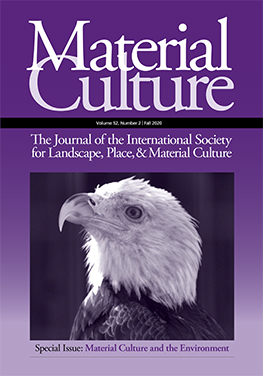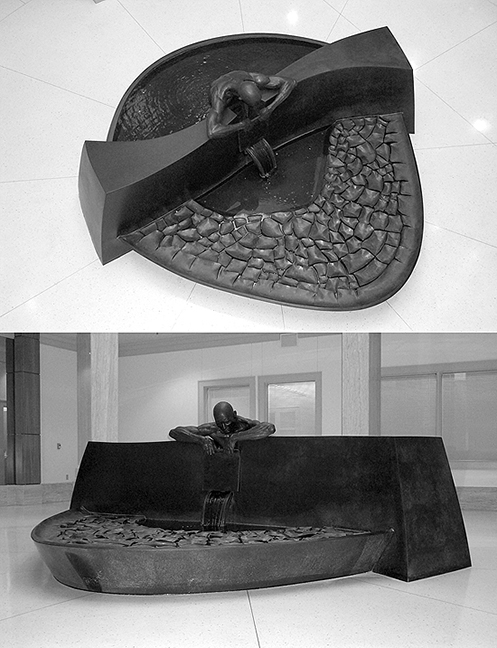Material Culture Culture is printed two times a year for members of PAS:APAL. It is abstracted and indexed in: JSTOR, ProQuest, History and Life, Historical Abstracts, GeoAbstracts, and the MLA International Bibliography. You may download a PDF of the table of contents of the current issue here. The Fall 2020 issue of Material Culture includes:
 The Effects of Cultural Disturbance on Acequias in the Upper Rio Grande Region
The Effects of Cultural Disturbance on Acequias in the Upper Rio Grande Region
By Jeffrey Smith, Department of Geography and Geospatial Sciences, Kansas State University
Abstract: Few things in the arid American Southwest are as vital to the survival of a community, or as important to the livelihood of the resident population, as a reliable source of water. When colonial Spanish settlers first arrived in the region, one of their first duties was the construction of a community acequia (irrigation ditch). Serving as a veritable lifeline for the community, acequias divert much needed water for croplands and household use. Once built, however, these earthen ditches require continual maintenance. For over four centuries, generations of Nuevomexicanos have followed the time-tested techniques of their forefathers in using and maintaining the acequias. A distinct cultural landscape developed. Throughout the upper Rio Grande region however, cultural and demographic change – especially depopulation among rural Hispanos and increasing urbanization – as well as growing concerns over sustainable water use are leading to an end to those practices. No longer are acequias being cleaned in the traditional, manual labor manner. Instead, modern irrigation technology is replacing the earthen ditches. These cultural disturbances are leading to modifications in the built environment and an erosion to the sense of community.

Two views of the Acequia fountain/sculpture by Timothy Hooton. On display on the first floor of the Capital North building, Santa Fe, New Mexico. Photo by author.
Educating with Skins and Bones: Material Representations of Animals in Permanent Exhibits at Local Parks
By Rebecca A. Johns and Rachelle Pontes, School of Geosciences, University of South Florida, St. Petersburg
Abstract: Abstract Permanent exhibits are common material artifacts at nature parks in the United States. Exhibits are designed to represent features of local ecosystems and convey important information about environment and place. While the environmental education literature is extensive, no one has yet applied a material culture analysis to deepen our understanding of the work that exhibits do to engage and educate visitors. We used material culture analysis to investigate animal exhibits at three nature parks in Florida. Animal bodies preserved through taxidermy stand beside displays of skeletons, skulls, individual bones, and animal pelts; nearby, live animals are confined to cages and terrariums, while wild creatures populate the parks’ outdoor spaces. We argue that animal remnants and the bodies of resident animals “speak” about human valuation of nature. Through rhetorical analysis of material and living exhibits, we ask: What normative messages are embodied in each type of animal display concerning human entanglements with non-human animals? Do exhibits encourage animals to be understood as persons establishing relational epistemologies? How do they leverage affective connection to promote more equitable and compassionate relations between humans and others? Conversely, do exhibits reproduce dominant discourses of scientific authority, human superiority and control of nature? Which displays are more potent in invoking animals as persons? This work occurs at the intersection of environmental education and material culture analysis. As environmental educators seek to increase their impact on the American public in a time of mounting environmental woes, permanent exhibits are an overlooked and little understood resource.
Commemoration through Cookbooks: A Recipe for Remembering Place and People after Disaster
Dr. Elyse Zavar, Department of Emergency Management and Disaster Science, University of North Texas, and Dr. Deborah Hann, Department of Social Sciences, Emporia State University
Abstract: As communities recover from disasters, people seek to regain a sense of normalcy in their daily lives. One routine that provides structure is cooking daily meals. This act of normalcy can provide comfort during the chaotic upheaval characteristic of the disaster recovery period. Recipe sharing and cookbooks offer a cathartic outlet for survivors and even serve as fundraisers to help with the recovery process. Importantly, these cookbooks represent a form of material culture and serve as commemorative artifacts that display a disaster’s impact while marking the reconstruction of place and recovery of people. In this research, we utilize content analysis to examine a set of cookbooks written in response to hurricane-induced disasters to understand how these cultural touchstones preserve memories and links to the past while aiding in individual and community recovery. Specifically, we examine the cookbooks as a repository of collective memory and analyze their preservation of material culture in the wake of disaster.
“I am coming home!”: Lieux de mémoire and Social Memory in the Post-Katrina Ninth Ward
By Alexandra Giancarlo, Indigenous Studies-Sociology, Western University
Abstract: In the Ninth Ward of New Orleans, memorials became important tools of community memory post-Hurricane Katrina. Using data collected from formal semi-structured interviews, photographs, the census, and community events, this paper engages with scholarly literature on lieux de mémoire, grassroots memorials, social (or collective) memory, and post-disaster memorialization to illustrate the importance of community memory in the re-making of the Ninth Ward after Katrina. I use one example of a grassroots memorial to illustrate the conceptualization and potential power of lieux de mémoire. This lieu de mémoire offered a public lamentation for lost kin, whom mainstream history was liable to forget, and served as a public “voice” that excoriated the injustices of the storm and the threats to the community’s endurance in the face
